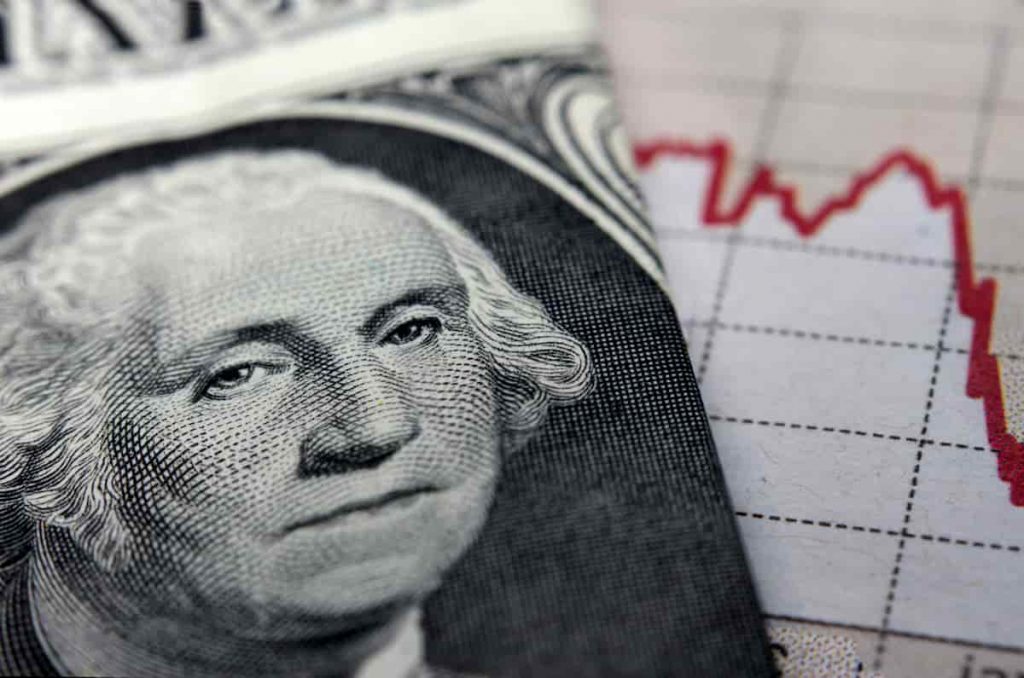Since the pandemic outbreak in March 2020, we have not had market corrections accompanied by declines of 10% or more in value.
On Monday morning on January 24, trade on the S&P 500 breached the 10% threshold before bouncing back. The Dow Jones Industrial Average at one point was down by 1000 points. Year to date the S&P 500 is down by 10.2%, Dow Jones -8.2%, NASDAQ -14.8%.

The stock rout is rather impressive: the S&P 500 is heading towards the worst January on record, and the NASDAQ, if the trend persists, might have the worst month since October 2008 – when it crashed 17.7%.
A rough start for 2022
The Federal Reserve System (or the Fed) indicated that tighter monetary policy is coming in December, and in early January, we learned that it is coming faster and more broadly. That information is already well communicated and baked into expectations. So why did markets fall so hard on Monday?
One explanation is rising geopolitical tensions. With Russia’s invasion of Ukraine looming high, it creates lots of uncertainty and heightens the risk of a wider conflict. Additionally, there are signs of slowing of the US economy over rampant Omicron variant spread. And there are indications of panic selling amplified by algorithmic trade. Algorithmic trading accounts for around 60-73% of the overall United States equity trading.
Not everything is “gloom and doom”
Some positive signs might emerge in the near term for stock markets. It is possible that markets got too pessimistic about expected political and economic events. As one of the famous investing quotes goes, “A Bull Walks up the Steps, a Bear Jumps out the Window.” This “sell everything” approach allows you to hunt for high-quality or value stocks at a competitive price.
Stocks could be primed for a cautious rebound given the lack of concrete new fundamental change. One reason would be the deflation of geopolitical tensions. Although the word “imminent” was used often to describe Russian plans towards Ukraine, it is unlikely that Moscow would initiate that kind of move before or during the winter Olympics in Beijing that is set to begin in just ten days. Such a move, no doubt, would upset Russia’s strategic partner China.
In the meantime, there are indications that Omicron spread may peak this week (new worldwide cases increased by 7.16 million cases faster in the week ending January 9 than the previous week, 3.54 million faster in the week of January 16, and 2.28 million faster in the week of January 23). This would give some relief to the markets, at least on the pandemic front.
Despite geopolitical tensions and aggressive monetary policy by the Fed, there still could be the case for a calculated value investing for a post-pandemic rebound play.
All that glitters is not gold
Looking from the historical perspective, we can recognize some stock market bubble elements that make it a lot harder for the market to exercise a soft landing. This is, perhaps, the main reason for a disappointing start of the year for stock markets. And it is not all the Feds fault.
One obvious reason is the valuation of stocks in general. It seemed that markets had no issues absorbing very active initial public offerings (IPOs) of the last two years. Overall, 2021 marked the strongest year for IPO listings and volumes in history, with the barrier of 1,000 offerings being hit in the last month of the year, according to Dealogic data, which showed a record $315 billion raised when that total had never before hit $200 billion in a year.

Investors rushed to jump on those IPO’s fearing to be left behind as prices kept steadily rising. The mood was akin to “anything sells.” This, of course, is a sign of the bubble, especially in so-called new energy sectors such as electric vehicles, hydrogen, etc.
The situation has a resemblance to the “dot-com” bubble as internet transformation was taking place. The crash that followed saw the NASDAQ index, which rose five-fold between 1995 and 2000, tumble from a peak of 5,048.62 on March 10, 2000, to 1,139.90 on October 4, 2002, a 76.81% fall.
By the end of 2001, most dot-com stocks went bust. Even the share prices of blue-chip technology stocks like Cisco (NASDAQ: CSCO), Intel (NASDAQ: INTC), and Oracle (NYSE: ORCL) lost more than 80% of their value. It would take 15 years for the NASDAQ to regain its peak, which it did on April 24, 2015.
The main problem during such a “gold rush” is the same as with the real gold rush. Because certainly, not everyone who came to California in the 1950s got rich. The same stands for any new industry, as profits remain elusive for many startup companies.
Therefore, any technological transformation doesn’t automatically guarantee profitability to companies who are making that transformation thus it is extremely hard to put a value on the company that hasn’t yet produced a single item, never mind selling anything. But thanks to enthusiastic investors, those companies are valued in tens of billions of dollars.
Hence, the market attracted lots of new investors who jumped into this bonanza. This phenomenon was discussed in Benjamin Graham’s investment book “The Intelligent Investor” in 1949 (the author lost all his investments in the 1929 stock market crash). The book famously inspired Warren Buffet to look at the financial fundamentals of any company he wished to invest in.
Disclaimer: The content on this site should not be considered investment advice. Investing is speculative. When investing, your capital is at risk.







